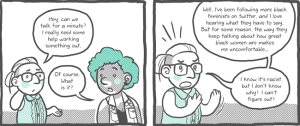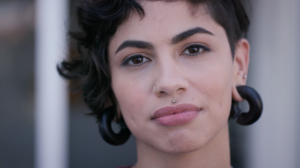When my daughter Sage was about four years old, I took her and her older sister, Marley (Mar), to a playground near our house.
We settled into our usual rhythm of picking out a shady area to set out our blanket, books, and nearly frozen juice boxes. Once we settled, Marley took Sage’s hand, and they walked over to the big yellow slide they both loved to explore. I began my usual ritual of laps around the play area, stopping in between to do a few lunges here, some squats there, always with a clear view of my girls.
About fifteen minutes in, I noticed Sage coming towards me. Her steps were brisk and focused; her eyes glassy with tears.
“What’s wrong, Sage?” I felt a little anxious because I hadn’t noticed what triggered her cry.
“It’s just that…” (She always started a sentence that way when she was particularly frustrated.) “… people keep talking on me, and calling me cute, and I don’t wanna be a cute; I just wanna play with Mar.”
This problem of people “talking on her” was not a new one.
Sage sees attention as something people try to place on her, usually without her permission. Even when the environments differ, her reaction is always the same.
Whether we’re in a friend’s home, sitting inside a classroom, running on a playground, or waiting in a lobby waiting to take violin lessons, Sage speaks when she wants, to whom she wants, and she is drained by attention and crowds.
None of this happens because Sage has adjustment issues or problems sharing her sister’s attention with other children. And it’s not because she’s shy, either.
Sage isn’t shy or asocial. She’s an introvert, and her innate reactions to attention and inquiry are completely normal for millions of people like her.
It can feel complicated for parents, who recognize that their child is quiet and reserved, to help their child feel confident about their communication style and personality. We want our children to comfortably thrive in social environments because we see that as a necessary life skill.
However, we can’t always see how to encourage that without pushing them into thinking they need to act in opposition to their natural way in order to make friends and be sociable.
We inadvertently confuse being sociable with having healthy social skills, but the two are not the same.
Sociability is an aspect of overall behavior. Healthy social skills don’t mean that a person has to be particularly charismatic or the life-of-the-party type. It is completely normal, for example, for a person who has positive social relationships, to also feel drained in environments with groups of people, prefer small group or person-to-person interaction, and be completely comfortable being alone.
An introverted child can have healthy social skills and not be a sociable person. Sage is exactly that way.
She, like all humans, was born with a predisposition that influences her personality type. Some people, extroverts, tend to feel energized and comfortable when they’re engaged in conversations and group activities.
And some, introverts, tend to feel exhausted by what feels like prolonged interaction, particularly in group settings, and prefer to be among people they already know or engaged in one-on-one conversation.
In raising my introverted child, I am learning about the many things I can do to both honor my daughter’s specific needs and encourage her confident self-expression.
Here are three things to consider as you discover ways to facilitate a space of comfort and support for a child in your life who isn’t traditionally expressive.
1. Help Your Child Understand What They Need in Order to Feel Comfortable
As Sage gets older, she seems to be more open about her needs. She’ll say, “I’m gonna stay home with Grandpa today because that noisy mall is not gonna work for me.”
Those assertions have clued me in over the years to what things feel comfortable for her – and what feels unsafe. With that knowledge, I can help her make choices that are healthier for her emotionally.
That way, I’m not being the comfortable space for her; instead, I’m showing her how she can do that for herself. As she grows into a teenager, then an adult, she’ll need to know what questions to ask in order to make informed choices about the environments she’s in.
I facilitate that by doing things like:
- Telling her in advance when we’re going somewhere that may be noisy or heavily populated
- Showing up to events early so she can get comfortable with the physical space
- Reminding her that she doesn’t have to make herself smile just to make other people comfortable
- Assuring her that she doesn’t have to be friendly – she just has to respond politely
By doing these things, I’m giving Sage examples of how to manage her environment without feeling the need to change other people’s behaviors.
All of those examples were specific to Sage, and don’t require her to do anything uncomfortable – including communicating with people “unnecessarily” (which is how it might feel for her) in order to feel safe in her environment.
Are there any in-advance preparations you’d feel comfortable making for the introverted child in your life?
What questions can you ask them to help you get clarity on when they’re doing something because they’re afraid or shy, and when they’re doing something to feel safe and comfortable?
Asking these questions is one effective way to both show your child that their needs matter to you, as their parent, and also to give them examples of how to assess and address those needs for themselves, as they grow older, and take on more responsibility, for their own comfort and their own sense of control.
2. Choose Activities for Them Based on Observation, Not Assumption
It may sound contrary to say that healthy parenting shouldn’t be based on that parent’s personal experiences, but it isn’t.
It’s easy to operate off the idea that whatever we lacked as children is exactly what we want to make sure our children have in their lives. But they are not us. They’re their own people with their own tendencies and emotional needs.
If I were to assume, for example, that it’s best for me to read a story to Sage every night, cuddled up with her and Goodnight Moon because that’s what I missed out on when I was four, I’d be wrong.
She doesn’t want anyone else in her bed, and she’d rather read the story herself, silently. Respecting her right to personal space and comfort on her terms is exactly the type of mother I want to be – because that’s what she needs.
Are you clear about the approaches that work best for your child?
Do they enjoy light touch during bedtime stories?
Would they prefer to read a story to you, aloud?
Might they prefer an audiobook to a tangible book?
Have you tried sitting with them for a few minutes at night instead of reading anything at all?
This observation-focused approach can also help you to and help them by bringing these observations to their attention, to get comfortable and clear about their own personalities, so they can better manage themselves by (eventually) making their own informed decisions.
3. Offer a Clear Example of a Healthy Emotional Environment
As I push my arm through the sleeve of this imaginary Parenting Is Not For Suckas! T-shirt, I imagine you smiling as I remind you that there are many options for ways to be there for our children, however they show up as themselves.
With an introverted child in particular, we’re not doomed to raising them to feel like they need to change something inherent in them (their standard for feeling safe and comfortable) in order for them to cultivate healthy social relationships. Or for them to be more friendly, more talkative in public, or more anything in order for people to be comfortable around them.
Oftentimes, parents and adults think that confident verbal expression, or the initiating of interaction, are the primary indicators of well-adjusted children. They are not.
This is why those ubiquitous and well-intended checklists and charts about what children should be doing by certain ages can actually be harmful. They can cause us to generalize children’s behaviors instead of doing the things that will help us understand the specific needs and nuances of our children.
Children are often forced into adults’ ideas of who and how they (the children) should be. That can cause unhealthy self-perception, which shows up when a child is always comparing themselves and their accomplishments to that of other children.
They will never be happy with themselves if they feel – especially through your lead – that they need to behave a certain way instead of being comfortable with the way they’d naturally behave.
That childhood experience, for many adults, births a long-standing sense of negative self-judgment, discomfort with one’s real personality, and even resentment toward parents (or people in general).
Thankfully, there are things we can do to walk consistently toward healthy self-perception for our children – and successful parenting for ourselves. It starts with paying attention to your child and making note of the instances and environments where they seem most comfortable.
To be clear, this isn’t about not trusting your instincts as a parent or caregiver, either. This is about observing with a level of openness and using those observations to make informed decisions about the types of settings you bring your child into.
This is just one way we can nurture confidence and healthy emotional management for the children we love. We can help them to understand themselves, we can honor what we learn about them, and we can give ourselves room to make mistakes, knowing that our intentions and our actions are in the right place.
***
Ultimately, we know that we’re raising adults. And if we can offer them an example of a space where it is normal and expected that they be fully themselves, they will thrive as adults – and they’ll be the type of people who give other people that same space as well.
[do_widget id=’text-101′]
Akilah S. Richards is a Contributing Writer for Everyday Feminism. She is a six-time author, digital content writer, and lifestyle coach who writes passionately about self-expression, womanhood, modern feminism, location independence and the unschooling lifestyle. Connect with Akilah on Instagram, Tumblr, or her #radicalselfie e-home, radicalselfie.com. Read her articles.
Search our 3000+ articles!
Read our articles about:
Our online racial justice training
Used by hundreds of universities, non-profits, and businesses.
Click to learn more





















